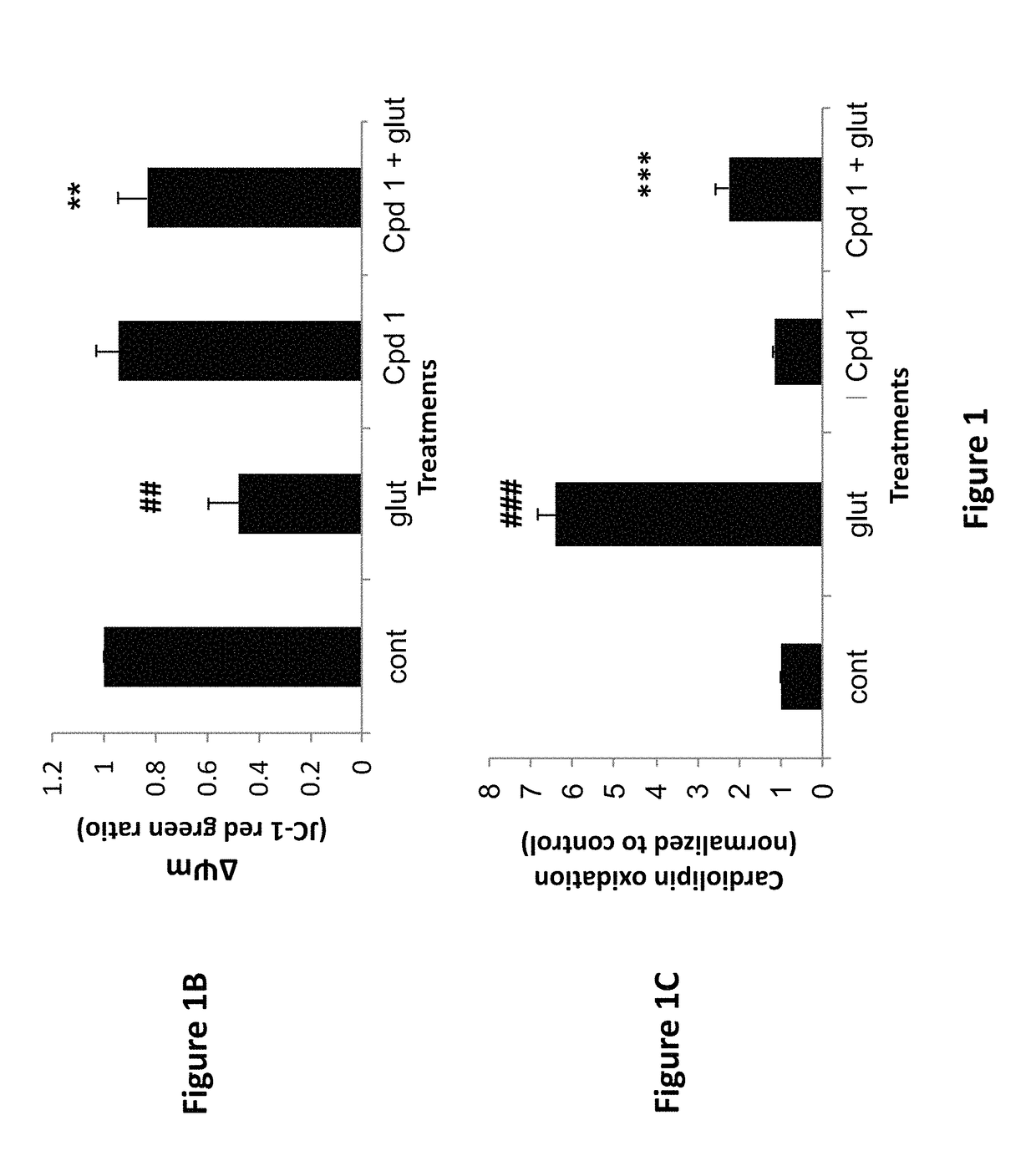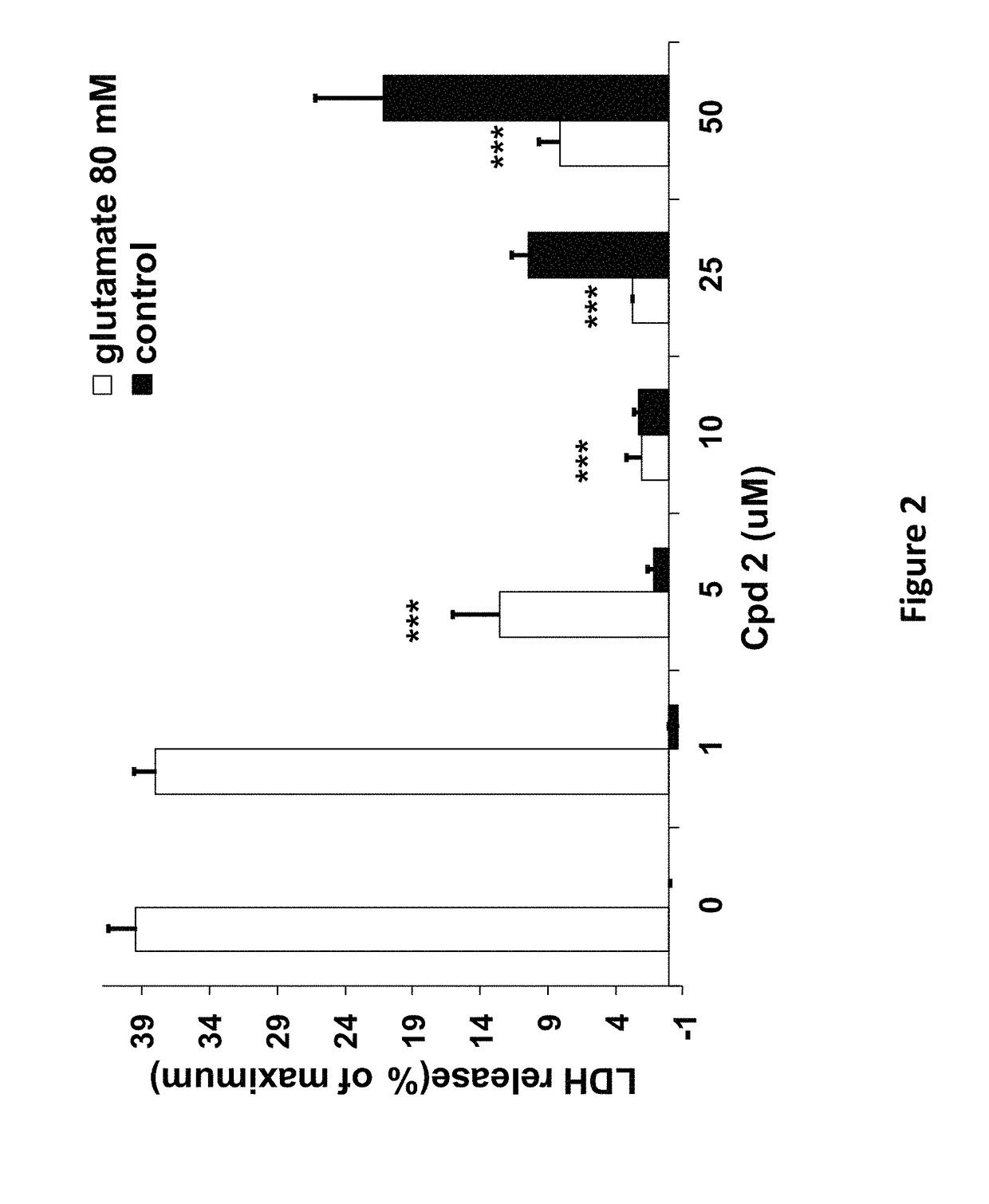Quinazoline scaffold based compounds, pharmaceutical compositions and methods of use thereof
a quinazoline and scaffold technology, applied in the field of quinazoline scaffold based compounds, can solve the problems that the approach has not matured to effective treatment, and achieve the effects of preventing cell death, preventing cell death, and improving neurodegenerative processes
- Summary
- Abstract
- Description
- Claims
- Application Information
AI Technical Summary
Benefits of technology
Problems solved by technology
Method used
Image
Examples
example 1
and Methods for Biological Assays
[0166]TSPO Binding and Western Blot Protein Analysis
[0167]TSPO binding assays were utilized to determine whether the compounds of the invention are able to compete with standard TSPO ligands, according to methods described previously (Veenman et al. 2004; Levin et al. 2005), and are used for quality control. Briefly, the assay utilizes radioactive standard ligand [3H] PK 11195 (1-(2-chlorophenyl)-N-methyl-N-(1-methyl-propyl)-3 isoquinolinecarboxamide), and measures the ability of the compounds of the invention to displace standard ligand in binding to TSPO. Total radioactive binding was determined by measuring the radioactivity of the radioactive ligand-receptor complex, obtained in the reaction of radioactive standard with the TSPO. Radioactive standard and the examined compound were added to the TSPO and after some incubation time the radioactivity of the resulting ligand-receptor complexes was measured with the help of a γ-counter. This radioactiv...
example 2
Binding to TSPO
[0174]Binding to TSPO was evaluated using a [3H]PK 11195 radio-assay, as described above.
[0175]Results of binding to TSPO and protective effects of the compounds of the present invention are provided in Table 1. Compounds 1-8 were tested in cell culture, and favored compounds also in animal models (i.e. Compound 1). The structures of these compounds are provided hereinabove. Table 1 also includes the compound encompassed by U.S. Pat. No. 8,541,428 (compound A).
[0176]
TABLE 1CompoundKi (nM)Protection*1≈60Excellent2≈380Good3≈1506Good4≈45Good5≈600Excellent6≈60Excellent7≈2.5Good8≈2.5GoodA≈600Good*Protection against glutamate-induced cell death
[0177]A comparison of Compound 1 of the present invention with Compound A, which is exemplified in U.S. Pat. No. 8,541,428, indicates that the nature of the alkyl groups on the N-amide moiety has a strong effect on the affinity of the compounds to TSPO, and most importantly that the asymmetric amide results in a combination of protect...
example 3
e Properties of Compounds of the Invention
[0180]The compounds of the invention protect against cell death induced by glutamate in cell culture of U118MG cells of astrocytic origin (FIGS. 1, 2, 3 and 8) or SH SY 6Y cells of neuronal origin (FIG. 4). FIG. 1 shows that Compound 1, which has good affinity for the TSPO (Table 1), prevents cell death and cell death processes induced by glutamate. As shown in FIG. 1A, Compound 1 of the present invention protects against glial cell death induced by 35 mM of glutamate in cell culture (Results are depicted as AVG±SD). In the control group, 35 mM of glutamate killed ˜60% of the cells. Compound 1 at concentrations from 10-100 μM significantly protects against cell death induced by glutamate in glial cell culture. In comparison, prior art Compound A (U.S. Pat. No. 8,541,428) is unexpectedly significantly less efficacious at protecting against cell death (FIG. 8A). * p<0.05 vs. glutamate exposure (glu), ***p<0.001 vs. glu. ###p<0.001 vs. vehicle ...
PUM
| Property | Measurement | Unit |
|---|---|---|
| structure | aaaaa | aaaaa |
| adhesion | aaaaa | aaaaa |
| physical | aaaaa | aaaaa |
Abstract
Description
Claims
Application Information
 Login to View More
Login to View More - R&D
- Intellectual Property
- Life Sciences
- Materials
- Tech Scout
- Unparalleled Data Quality
- Higher Quality Content
- 60% Fewer Hallucinations
Browse by: Latest US Patents, China's latest patents, Technical Efficacy Thesaurus, Application Domain, Technology Topic, Popular Technical Reports.
© 2025 PatSnap. All rights reserved.Legal|Privacy policy|Modern Slavery Act Transparency Statement|Sitemap|About US| Contact US: help@patsnap.com



